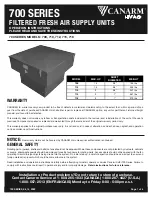
3
4.4 Duct connection
In order to achieve the capacities stated
on the performance curves the fans must
be provided with ducts as shown in fig.
7 and fig. 8.
The duct or inlet cone on the fan inlet
side must be designed to ensure smooth
and undisturbed flow of the air; avoid,
for instance, sharp duct bends immedi-
ately in front of the inlet opening. Flexi-
ble connections must be placed at least
0.5 x the impeller diameter in front of the
leading edge of the impeller.
ACN-ACW-ARN fans are prepared for
circular duct connection on both inlet
and outlet sides.
Flanges supplied as standard
for type ACN comply with EUROVENT
1/2.
Flanges supplied as standard for type
ACW comply with DIN 24154 row 4.
Systems with higher vibration level or
more exacting performance require-
ments must be provided with expansion
joints between fan and duct, and ducts
must not be supported by the fan.
It is important to allow for free areas to
facilitate mounting and dismounting as
well as ordinary maintenance.
4.5 Electric connection
Connection to the mains is effected direct
in the motor terminal box or in the termi-
nal box mounted on the outside of the
fan casing.
For 3-phase motors the cables are con-
nected according to connection diagram
on the inside of the terminal box lid.
For 1-phase motors see connection dia-
gram for 1-phase, adjustable motors.
Having wired the motor terminal box,
check that the direction of rotation of the
impeller complies with the arrow-plate
fitted on the outside of the fan.
For reversible fans (alternating direc-
tions of rotation) a time delay arrange-
ment must be provided to ensure that the
impeller is stationary before restarting.
5. Start of operation
5.1 Prior to start of operation
Prior to start of operation check that the
fan and duct connections are clean and
free from tools and foreign substances.
Also check that the electric connections
meet the prescribed requirements, that
any wire guard fitted on the fan inlet or
outlet side is correctly mounted and that
the direction of rotation of the fan com-
plies with the arrow-plate (check by
short-time operation).
5.2 Motors with Y/
Δ
starting
The relay must be set to the calculated
time.
5.3 Starting procedure
Start the fan.
The maximum allowable fan speed de-
pends among other things on the ambi-
ent temperature and the space in front
and behind of the fan. Refer to the Air-
Box calculation program and technical
fan specifications.
Check that no abnormal noises occur.
See that the vibration level is normal. The
vibration level at the fan operating speed
must not exceed 7 mm/s rms, measured
radially at 2 points, 90
º
offset and at the
free shaft end of the motor. Otherwise,
the fan must be balanced. Operation at a
higher vibration level exceeding 11 mm/
s rms* is not allowed in case of fixed fan
position.
Operation at a higher vibration level ex-
ceeding 18 mm/s rms* is not allowed in
case of position on feet or anti-vibration
mountings.
After 30 minutes of operation check that
the fan operates normally.
* ISO 2954, Requirements for instru-
ments for measuring vibration severity.
6. Maintenance
6.1 Protection prior to inspection
and maintenance
When the fan is out of operation for rea-
sons of inspection or repair/mainte-
nance, the electric system must be
switched off and protected so that the fan
is not cut in unintentionally.
Fig. 7. Installation in duct system
Fig. 8. Inlet cone for connection to duct
Fig. 9. Optimal installation
Fig. 10. Minimum installation
3 x D
>
3 x D
>
½D
r >
D
>
D
>
D = Fan diameter
Built into duct
Free inlet
D
>
D
>
½D
r >
½D
>
D
>
Built into duct
Free inlet
D = Fan diameter
Fig. 11. Dismounting/mounting of axial flow fan type ACN/ACW/ARN

























